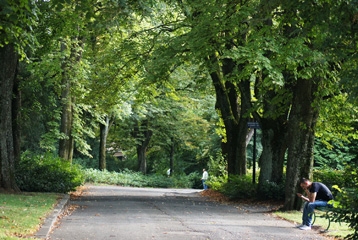Mainly covering a plain subject to frequent flooding, the Acacias Bâtie district was shown in a favourable light first in the Middle Ages then more particularly in the 20th century.
Development of the district: from meadow to industry
An initially remote zone
In the Middle Ages, the sectors of les Acacias and la Praille were a dependence of the seigneury of Lancy then that of Bâtie-Meillé in 1317. Only les Vernets belonged to Geneva. The zone was remote: it took almost one hour’s walk to reach the city’s fortifications and a single bridge crossed the river Arve. The Drize and the Aire often burst their banks. Drainage works in the Middle Ages allowed market gardening activities to be developed near the Arve with livestock farming near la Praille.
Trade with the city
Savoy and Geneva were fighting over the left bank of the Arve. It was finally attributed to Geneva at the start of the 19th century. It was also during this century that the sector developed. Trade with the city increased considerably. The Sentier des Acacias became a road in 1878, the tram crossed the Arve in 1889 and several bridges were built across the river.
Major developments
At the turn of the 20th century, major developments were planned for la Praille, in particular with the construction of a goods station. A planned Cornavin-Eaux-Vives rail link, the ancestor of the CEVA, pushed the canton and CFF to buy land in the Praille-Acacias-Vernets zone. Extensive infrastructure works were launched, such as the channelling of the Drize and the Aire or the construction of the Route des Jeunes, about which there are several anecdotes.
Birth of the industrial zone
The construction of the railway attracted companies to the district of les Acacias. In 1950, the canton bought all the land in the area from CFF, except that on which the station was built, and decided to make it into an industrial zone (IZ). Companies could rent plots of land for 90 years, under the surface right system. The IZ quickly became a success: in 2 years, 21 companies set up business in the south of the zone and a further 21 in the north. Before the 1960s, the zone had almost no buildings. The industries that moved in could give free rein to their imagination and test architectural innovations.
A dynamic future for the young district of les Acacias
At the beginning of the 21st century, the les Acacias district is still young. With the major development project for the Praille-Acacias-Vernets (PAV) zone, it still has a great deal of growing to do!
La Queue d'Arve: a “village” in the marshes
In the 19th century, the area where the Queue d'Arve sports centre is built was a vast marsh. Driven by the economic crisis, unemployed people, fairground folk or travellers set up home there in trailers or makeshift huts. Vegetable patches, rabbits and goats gave this “village”, with its own chapel, a somewhat rural feel. In the 1930s, it was planned to build a river port on this land to serve Geneva, but the project never came to pass. The frequent flooding of the sector was brought to an end in 1935 with the containment of the Aire, a tributary of the Arve.
The Bois-de-la-Bâtie: a public promenade for eternity
Throughout the centuries, the Bois-de-la-Bâtie was always considered to be a public area. However, it was only in 1868 that some dignitaries from Geneva, the Turrettini brothers, bought the different plots of land and offered them to the city on condition that the place remained a public promenade “for eternity”. Its natural forest of oak and hornbeam was considered exceptional in the region and was carefully managed by the Parks and Gardens Department (SEVE). In 1982, a wildlife park was set up with the aim of familiarising young city-dwellers with the local animals. Old Swiss breeds of animal, in danger of becoming extinct, are just some of the curiosities in the district.
What do “les Acacias” and “Bâtie” mean?
The word “Acacia” refers to a species of tree in the same family as the mimosa. However, the trees which gave their name to the district were incorrectly referred to as acacias. They were in fact robinia, originally from North America. These trees were brought to Europe in the 16th-17th centuries. The district of Acacias owes its name to the hamlet which previously stood on the site of the current carrefour de l’Etoile.
The name Bois-de-la-Bâtie comes from the name of a fort, the Bastie-Mellié, built in 1318 and which fell into ruin in the 16th century.
Major works: key dates
The left bank of the Arve underwent major infrastructure works before becoming an industrial zone. The aim was to attract companies which would use the railway as a means of transporting their goods:
- 1919: land purchased by the canton and CFF;
- 1935: start of the Drize and Aire channelling work;
- 1960: completion of the goods station in la Praille;
- End of the present decade: major works are scheduled for the Praille-Acacias-Vernet (PAV) area.
Sources:
- Bénédict Frommel and Enis Arikok, Secteur Praille-Acacias-Vernets. Etude historique et patrimoniale, Geneva: Monuments and Sites Department, 2006
- City of Geneva, under the direction of Rafael Matos-Wasem, Genève à pied. 10 parcours à thèmes, Geneva: Ed. Slatkine, 2008
Article modifié le 25.09.2020 à 17:05

